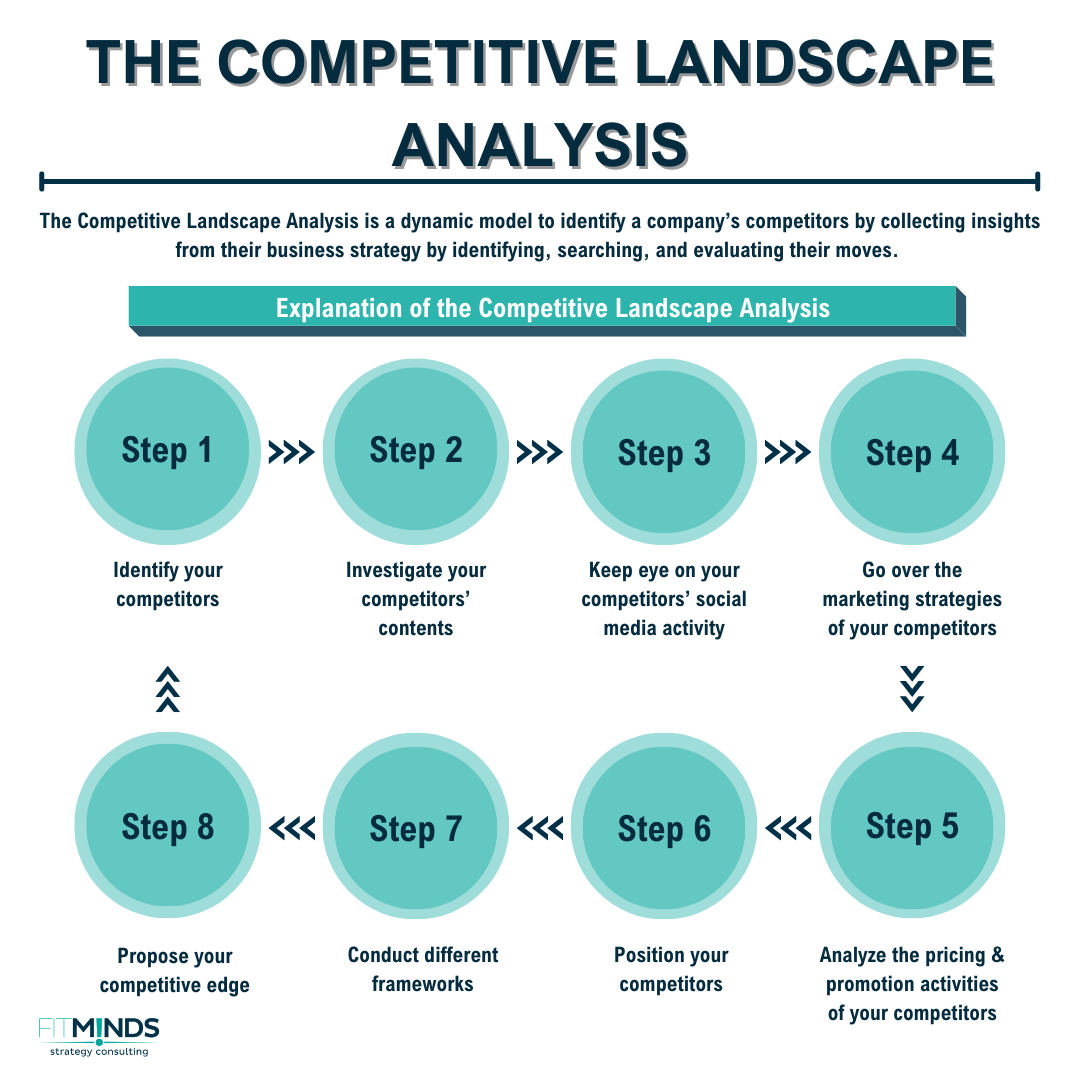The Competitive Landscape Analysis is a dynamic model to identify a company’s competitors by collecting insights from their business strategy by identifying, searching, and evaluating their moves. In other words, The Competitive Landscape Analysis assists companies in analyzing their competitors’ strengths and weaknesses. In a sense, it enables companies to identify their direct and indirect competitors and analyze their mission, vision, values, strengths, weaknesses, position, and value proposition. To analyze that, competitors’ market share, marketing strategies, prices, launches, and business activities are searched.
Main Benefits of the Competitive Landscape Analysis
For all industries around the world, identifying and analyzing competitors carries high importance. Collecting information about your competitor creates advantages for the competition in the market. These advantages could be listed as developing new goals, identifying market trends that your firm is operating, improving your business strategy through the creation of unique value propositions, etc.
The Competitive Landscape Analysis helps you:
- To create a competitive benchmark as a starting point
- To develop new goals
- To analyze the market structure and market trends
- To prepare a unique value proposition for the company’s products and services
- To modify the business strategy
- To go over opportunities and create the future direction
Explanation of the Competitive Landscape Analysis
The Competitive Landscape Analysis is a dynamic model because the market environment is changing due to changes in technology, customer behavior, purchasing behavior of the customers, competitors’ moves, etc. That is why dynamism is essential for Competitive Landscape Analysis. The roadmap for the Competitive Landscape Analysis is based on the following 8 steps:
Step 1: Identify your competitors
Step 2: Investigate your competitors’ contents
Step 3: Keep eye on your competitors’ social media activity
Step 4: Go over the marketing strategies of your competitors
Step 5: Analyze the pricing & promotion activities of your competitors
Step 6: Position your competitors
Step 7: Conduct different frameworks
Step 8: Propose your competitive edge
Let’s go over these step by step.

Step 1: Identify Your Competitors
For analyzing your competitors properly, you can start by listing your competitors. Even though it depends on the industry and market dynamics, you can select the number of core competitors. Let’s say you can choose up to ten competitors. For classifying your competitors, you can segment them under four categories: direct competitors, indirect competitors, perceived competitors, and aspirational competitors.
- The Direct Competitors: These types of competitors share the most similarity with your business. These competitors have similar products or services, business offers, and targeted audiences. From the audiences’ perspective, these brands, your direct competitors, and your company take the same place in the decision to purchase. To make it clear, let’s give an example. For Apple, in terms of iPhones, Samsung and its cell phone series are the direct competitors.
- The Indirect Competitors: In this segment, the companies are differentiated in the premise of the product or service which means in terms of the targeted audiences. The companies in this group offer a higher or lower version of your product/ service. Due to divergences in the versions of products or services, the targeted audiences are different from your company. With an example, let’s make it more understandable. For instance, Apple and Samsung are direct competitors. Sony offers low-ended versions of the cellphones, so Sony is the indirect competitor of Samsung and Apple.
- The Perceived Competitors: The companies in this segment offer fundamentally different products or services from your company. In this manner, it sounds like they are not classified as competitors for your company. But, from the customers’ perspective, your company can be seen as a competitor for these firms. For instance, Ferrari and Lamborghini are the direct competitors in the high-segment sports car market. Volvo is the perceived competitor of Ferrari and Lamborghini because the cars of Volvo are different from the car versions of the other companies.
- The Aspirational Competitors: This segment refers to the potential competitors for your business. Currently, these companies do not offer the same or similar products/ services in comparison to yours but they can be related to your field. In this case, they can offer similar products/services in the future.
Step 2: Investigate Your Competitors’ Contents
After listing and segmenting your competitors, the next step is the investigation of your competitors’ content. The reason behind it can be expressed as figuring out the value propositions and brand positionings of these competitors, finding the strategy or content of their messaging to express their brand positioning, and comparing these with your business. In this manner, you should consider the channels that are used by your competitors. They could be websites, e-books, social media accounts, videos, custom imagery, blog posts, etc.
Step 3: Keep Eye on Your Competitors’ Social Media Activity
The next step is tracking your competitors’ social media activity. In this century, with the rising trend of social media usage, companies and their branding strategies in terms of value propositions, marketing strategies, launch strategies, etc. become more public. Social media accounts provide an important treasure for companies to keep eye on their competitors. They are important because, in social media accounts, companies try to build a communication channel between the company or brands and their customers. That is why, it is a true and reliable source for gathering information on their launch plans, value propositions, brand positioning, marketing strategies, customer activities, etc. So, you should put a close eye on the social media accounts of your competitors.
Step 4: Go Over the Marketing Strategies of Your Competitors
With collecting the marketing strategies of your competitors from their social media accounts, you need to gather the other marketing activities from other channels such as search engines. For reviewing these marketing strategies, you need to understand the way that it impresses the customers. So, put yourself into the targeted customers’ shoes. Going over their marketing strategy in this way. Besides, you also check for the position of your company. Let’s give an example. Volvo as a car manufacturing company has a value proposition as “the safest cars”. So, Volvo desires to come up as the top results in search engines when customers search “safety cars, cars, safety, secure cars”.
Step 5: Analyze the Pricing & Promotion Activities of Your Competitors
A true pricing strategy is also important for building the proper relationship with your customers. You need to analyze the pricing strategy of your competitors and try to collect the pricing details. This will help you to position your company in terms of price among its competitors. True pricing is crucial because if you are overcharging your customers that you are pricing way higher than your competitors, you probably lose your potential customers due to budget constraints. Also, undercharging or pricing your products and services a way lower than your competitors can damage your brand image and/or make low profits.
Step 6: Position Your Competitors
Another important step in the competitive landscape analysis is the determination of your business’ position among its competitors. We started to conduct the proper competitive landscape analysis with the identification of your company’s competitors. In each step, the necessary information about your competitors is collected to position your company and its competitors in the market or industry. To defend your company’s products or services against your competitors, you need to locate the position of your competitors. In this way, you can also identify the probable areas to disrupt the market or gain more market share.
Step 7: Conduct Different Frameworks
Many other models or frameworks are useful tools to conduct competitive landscape analysis. The competitive landscape analysis could be conducted for different strategic purposes such as creating or revisiting marketing strategies, positioning your products/ services, and improving the channels to build communication channels with your customers. Also, the competitive landscape analysis is an umbrella term for the models or analysis such as SWOT Analysis (Strengths, Weaknesses, Opportunities, and Threats Analysis), PEST Analysis (Political, Economic, Social and Technological Analysis), Porter’s Five Forces, Strategic Group Analysis, Growth Share Matrix, Perceptual Mapping, etc. For all these models and analyses, the common or share point is the steps that we listed above, investigating your competitors.
Step 8: Propose Your Competitive Edge
The last step in this roadmap is anticipating the needs all your business environment such as your employees, society, customers, etc. Again, this is not a static model, it is dynamic by its nature. In the end, your business tries to perform its best by proposing its competitive edge and imposing them on its business environment.
How to apply the Competitive Landscape Analysis?
Contact us to apply the Competitive Landscape Analysis to your business, FITMINDS is providing an adoption of the Competitive Landscape Analysis Engagement Journey that fits your company and your company’s needs.
Additional Tips and Readings
- To learn more about the PEST Analysis you can check our article and contact us to imply your business.
- To read more about Growth Share Matrix, you can read our article, A Practical Tool to Start Portfolio Optimization: BCG Matrix or Growth- Share Matrix, and contact us to imply your business.
- To examine Perceptual Mapping more, you can read our article Perceptual Mapping: Visualize Your Competitive Position and contact us to imply it to your business.
- To learn more about Porter’s Five Forces, you can read our How to Analyze the Competition with Porter’s Five Forces – An Ultimate Guide article, and contact us to imply your business.
- Also, you can read about the version of the SWOT Analysis, which is called TOWS Analysis, you can check our article, What is TOWS Analysis and How to Apply it?



13 comments
Pingback: get androxal buy online canada
Pingback: rifaximin no s consult
Pingback: cheap enclomiphene without a rx
Pingback: kamagra pas cher à vendre sans prescription requise
Pingback: ordering dutasteride price new zealand
Pingback: order flexeril cyclobenzaprine generic when available
Pingback: order gabapentin canadian pharmacy no prescription
Pingback: buying fildena australia no prescription
Pingback: cheap itraconazole buy in the uk
Pingback: get avodart generic sale
Pingback: buy staxyn price from cvs
Pingback: get xifaxan generic available
Pingback: kanadský nejlevnější kamagra
Comments are closed.